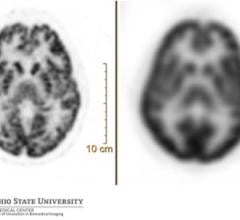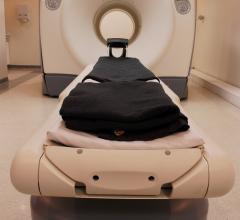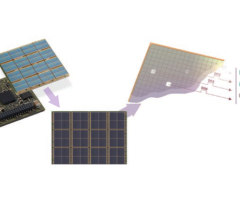The addition of magnetic resonance (MR) imaging and spectroscopy to positron emission tomography (PET) is more expensive ...
PET Imaging
Positron emission tomography (PET) is a nuclear imaging technology (also referred to as molecular imaging) that enables visualization of metabolic processes in the body. The basics of PET imaging is that the technique detects pairs of gamma rays emitted indirectly by a positron-emitting radionuclide (also called radiopharmaceuticals, radionuclides or radiotracer). The tracer is injected into a vein on a biologically active molecule, usually a sugar that is used for cellular energy. PET systems have sensitive detector panels to capture gamma ray emissions from inside the body and use software to plot to triangulate the source of the emissions, creating 3-D computed tomography images of the tracer concentrations within the body.
October 1, 2013 — Based on its recent analysis of the molecular imaging market, Frost & Sullivan recognizes Siemens ...
September 26, 2013 – At the 55th American Society for Radiation Oncology (ASTRO) annual meeting, Sept. 22-25 in Atlanta ...
Digital technology is opening remarkable opportunities for clinical positron emission tomography (PET) about which ...
September 6, 2013 — For patients with degenerative cervical myelopathy, imaging with 18F-FDG positron emission ...
September 3, 2013 — Researchers from University Hospitals Case Medical Center have published findings that a new form of ...
August 7, 2013 — A more precise method for determining bone marrow involvement in patients with diffuse large B-cell ...
Precision can have an enormous impact on patients. From diagnosis to patient monitoring (see “How Digital PET/CT Can ...
July 29, 2013 — GE Healthcare has initiated a Class I recall of most of its SPECT nuclear imaging systems and called for ...
Coronary artery disease (CAD) is a major cause of death in modern industrialized countries. Assessments of regional ...
Just when positron emission tomography (PET) appears to be eclipsing single photon emission computed tomography (SPECT) ...
PET is getting ready to venture outside oncology, cardiology and mainstream neurology. High on the list of new clinical ...
July 12, 2013 — Biopharmaceuticals Inc. announced the first subject has been enrolled in its NAV4694 global, pivotal ...
July 11, 2013 — The Society of Nuclear Medicine and Molecular Imaging (SNMMI) and the Alzheimer Association have ...
The Society of Nuclear Medicine and Molecular Imaging (SNMMI) is disappointed in the draft Medicare decision from the ...
Analog is approximate. Digital is specific. Therein lies the fundamental difference between digital PET and its analog ...
Peter Herscovitch, M.D., SNMMI president-elect, explains the advances in molecular imaging for Alzheimer's disease and ...
June 20, 2013 — A relatively new weapon in the fight against childhood brain cancer has emerged that improves upon ...
June 19, 2013 — Alzheimer’s disease has been linked in many studies to amyloid plaque buildup in the brain, but new ...
June 19, 2013 — Coronary artery disease (CAD) is one of the world’s most prevalent and silent killers. Positron emission ...
June 19, 2013 — Researchers have yet again been sent back to the drawing board in the development of the much-sought ...
June 19, 2013 — Using positron emission tomography (PET) imaging of the brain, researchers have identified a sweet spot ...
When prostate cancer makes a comeback, it becomes increasingly important to have exceptional imaging available to find ...
One of the biggest hurdles of hybrid positron emission tomography and magnetic resonance (PET/MR) imaging is the ...


 October 01, 2013
October 01, 2013 















